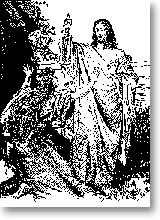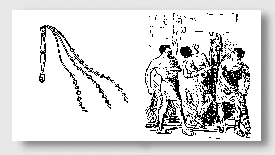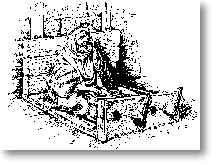Eyewitness Accounts Attest
to Resurrection
Multiple eyewitness accounts do not guarantee reliability, but they do
add extremely powerful evidence for the resurrection of Jesus. Indeed, it would be
unreasonable to conclude that hundreds of eyewitnesses to Jesus' appearances during the
forty day period following His resurrection were lying or were all experiencing the same
illusion.
Mary Magdalene, Mary the mother of James and Salome
Witness the Empty Tomb
When the Sabbath was over, Mary Magdalene, Mary the mother of James,
and Salome bought spices so that they might go to anoint Jesus' body. ...As they entered
the tomb, they saw a young man dressed in a white robe sitting on the right side, and they
were alarmed. "Don't be alarmed," he said. "You are looking for Jesus the
Nazarene, who was crucified. He has risen! He is not here. See the place where they laid
him." -- Mark 16:1-6

"When Jesus rose early on the first day of the week, he appeared
first to Mary Magdalene, out of whom he had driven seven demons." - Mark 16:9
Guards Witness the Opening of the Tomb by an Angel
Matthew 28:1-6 clearly states that the guards witnessed the rolling back
of the stone, were frightened and became like dead men.
After the Sabbath, at dawn on the first day of the week, Mary
Magdalene and the other Mary went to look at the tomb. There was a violent earthquake,
for an angel of the Lord came down from heaven and, going to the tomb, rolled back the
stone and sat on it. His appearance was like lightning, and his clothes were white as
snow. The guards were so afraid of him that they shook and became like dead men.
The angel said to the women, "Do not be afraid, for I know that you are looking for
Jesus, who was crucified. He is not here; he has risen, just as he said. Come and see the
place where he lay. Matthew 28:1-6
The Jewish priests had a problem. The Roman guards had witnessed the
angel roll back the stone and had seen the empty tomb. If word were to spread of this
event, the Jewish power structure might fall. To correct this problem, the Jewish
authorities (chief priests) bribed the Roman guards to circulate a false story to explain
the empty tomb of Jesus. |
While the women were on their way, some of
the guards went into the city and reported to the chief priests everything that had
happened. When the chief priests had met with the elders and devised a plan, they gave the
soldiers a large sum of money, telling them, "You are to say, 'His disciples came
during the night and stole him away while we were asleep.' If this report gets to the
governor, we will satisfy him and keep you out of trouble." So the soldiers took the
money and did as they were instructed. And this story has been widely circulated among the
Jews to this very day. Matthew 28:11-15 Some Bible
commentators suggest that the Roman guards went to the priests to save themselves since
they would be punished severely for letting the tomb be opened. If that is so, why would
the priests have to bribe the guards? It would seem reasonable that if the guards
were running for their lives, they would be willing to pay the priests to save themselves.
It seems likely that the priests were at a disadvantage because they had to bribe the
guards. Further, the priests had to offer the guards a large sum of money to lie,
probably because the guards would be risking their lives by saying they fell asleep on
duty.
The priests were not fools. If the guards returned to their officers and
demonstrated their story with physical evidence and eyewitness testimonies, the Roman
officers might believe them. The likely result would be that people would believe that
Jesus truly was the Messiah and the authority of the priests would greatly diminish.
Jesus Appears to the Eleven Disciples
After His resurrection, Jesus appeared several times to the eleven
disciples. What is striking about these appearances is that although He travels through
solid objects and appears and disappears at will seemingly independent of geographic
location and physical objects, He states that He is flesh. He invites the disciples to
touch Him and prove to themselves that it is He in the flesh.
"Then the eleven disciples went to Galilee, to the mountain
where Jesus had told them to go. When they saw him, they worshipped him; but some doubted.
Then Jesus came to them and said, "All authority in heaven and on earth has
been given to me" -- Matthew 28:16-19
"Later Jesus appeared to the Eleven as they were
eating;..." -- Mark 16:14
When he was at the table with them, he took bread, gave thanks, broke
it and began to give it to them. Then their eyes were opened and they recognized him, and he
disappeared from their sight. -- Luke 24:30-31 |
"They got up and returned at once to
Jerusalem. There they found the Eleven and those with them, assembled together and saying,
"It is true! The Lord has risen and has appeared to Simon.... While they were still
talking about this, Jesus himself stood among them and said to them, "Peace be
with you." They were startled and frightened, thinking they saw a ghost. He said to
them, "Why are you troubled, and why do doubts rise in your minds? Look at my
hands and my feet. It is I myself! Touch me and see; a ghost does not have flesh and
bones, as you see I have." When he had said this, he showed them his hands and
feet." -- Luke 24:33-40 "A week later his
disciples were in the house again, and Thomas was with them. Though the doors were
locked, Jesus came and stood among them and said, "Peace be with you!"
Then he said to Thomas, "Put your finger here; see my hands. Reach out your hand
and put it into my side. Stop doubting and believe." Thomas said to him, "My
Lord and my God!" Then Jesus told him, "Because you have seen me, you have
believed; blessed are those who have not seen and yet have believed." -- John
20:26-29
Jesus Appears to The Women
"When Jesus rose early on the first day of the week, he appeared
first to Mary Magdalene, out of whom he had driven seven demons." -- Mark 16:9
"So the women hurried away from the tomb, afraid yet filled with
joy, and ran to tell his disciples. Suddenly Jesus met them. "Greetings," he
said. They came to him, clasped his feet and worshipped him." -- Matthew 28:8-9
Jesus Appears to Hundreds of People
It is logical to assume that if Jesus' disciples were fabricating a
false resurrection story, they would attest to seeing Jesus, however, hundreds of
people witnessed Jesus in the flesh following His resurrection.
"After that, he [Jesus] appeared to more than five hundred of
the brothers at the same time, most of whom are still living, though some have fallen
asleep." -- 1 Corinthians 15:6
Jesus Resurrected Others
Jesus resurrected many others. Following Jesus' resurrection these
resurrected people went into Jerusalem and appeared to many people. Their resurrections
also testify of Jesus' resurrection and deity.
It is no accident that Jesus rose on the feast of First Fruits because
He fulfilled the Spring Feasts of Israel with His life.5 On the feast of First Fruits, it was the obligation of every Jew to offer the
first of their harvest to the Lord. Jesus fulfilled this obligation by resurrecting people
as His offering.
The tombs broke open and the bodies of many people who had died were
raised to life. They came out of the tombs, and after Jesus' resurrection they went
into the holy city and appeared to many people -- Matthew 27:52-53 |
 Did Jesus really
die -- or was he resuscitated after being taken from the cross? Was His body stolen from
the tomb? Jesus' life and death have been the subject of many recent publications. Some
"scholars" dispute Jesus' resurrection, although no archaeological, historical
or scientific evidence has ever been presented to disprove that it occurred. The death,
burial and resurrection of Jesus was observed by hundreds of eyewitnesses. The events were
recorded in a proven reliable record, the Bible.
Did Jesus really
die -- or was he resuscitated after being taken from the cross? Was His body stolen from
the tomb? Jesus' life and death have been the subject of many recent publications. Some
"scholars" dispute Jesus' resurrection, although no archaeological, historical
or scientific evidence has ever been presented to disprove that it occurred. The death,
burial and resurrection of Jesus was observed by hundreds of eyewitnesses. The events were
recorded in a proven reliable record, the Bible.  The flagrum was used to beat prisoners.
The sharp pieces of bone and lead on the leather thongs would cut into the back and
shoulders of the prisoners with each stroke, eventually opening the back to expose the
interior organs.
The flagrum was used to beat prisoners.
The sharp pieces of bone and lead on the leather thongs would cut into the back and
shoulders of the prisoners with each stroke, eventually opening the back to expose the
interior organs.

 Following
Jesus' resurrection, the apostles, former cowards, chose to die rather than deny the
resurrection and deity of Jesus.
Following
Jesus' resurrection, the apostles, former cowards, chose to die rather than deny the
resurrection and deity of Jesus.